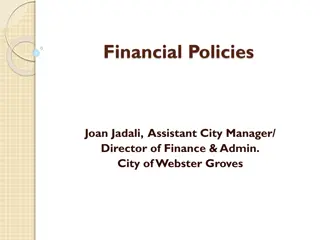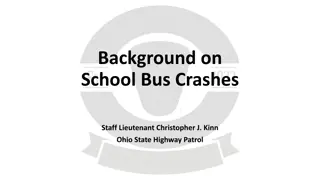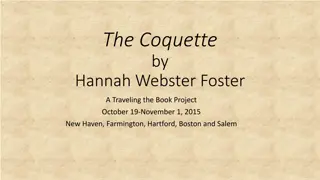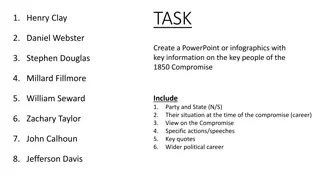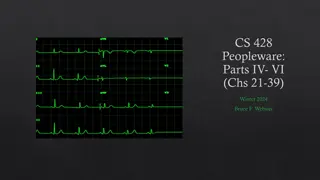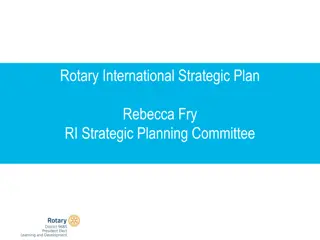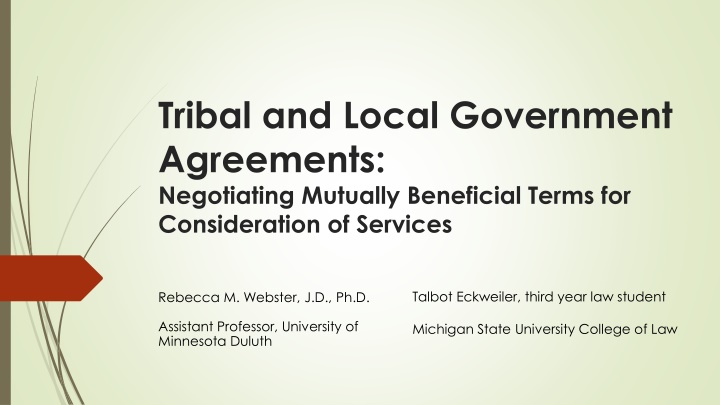
Negotiating Mutually Beneficial Terms for Tribal and Local Government Agreements
Exploring the unique challenges faced by governments on Indian reservations in providing services due to overlapping tribal and local jurisdictions, non-contiguous land patterns, and a mix of tribal and non-member residents. This research delves into historical backgrounds, current political landscapes, and the complexities of tribal and local government relationships, offering insights on navigating conflicts and barriers to calculating costs for government services.
Download Presentation

Please find below an Image/Link to download the presentation.
The content on the website is provided AS IS for your information and personal use only. It may not be sold, licensed, or shared on other websites without obtaining consent from the author. If you encounter any issues during the download, it is possible that the publisher has removed the file from their server.
You are allowed to download the files provided on this website for personal or commercial use, subject to the condition that they are used lawfully. All files are the property of their respective owners.
The content on the website is provided AS IS for your information and personal use only. It may not be sold, licensed, or shared on other websites without obtaining consent from the author.
E N D
Presentation Transcript
Tribal and Local Government Agreements: Negotiating Mutually Beneficial Terms for Consideration of Services Talbot Eckweiler, third year law student Rebecca M. Webster, J.D., Ph.D. Assistant Professor, University of Minnesota Duluth Michigan State University College of Law
Topics Problem Statement Historical Background Research Questions Nature of the Study & Data Sources Results including textual examples from IGAs Conclusion
Problem Statement Governments on Indian reservations face unique issues relative to providing government services Overlapping layers of tribal and local jurisdiction Non-contiguous land ownership patterns Mix of tribal member and non-member residents Little guidance for tribal and local governments when considering how to to acknowledge and account for the services they each provide
Congressional Eras Leading to Current Political Landscape Era Treaty Making Cherokee Cases & Indian Removal Allotments & Attempted Assimilation IRA and Preservation of the Tribes Termination & Relocation Tribal Self-Determination Time Frame Contact-1820 1820-1887 1887-1934 1934-1953 1953-1968 1968-present
Current Political Landscape 56.2 million acres of land in the United States held in trust for tribes on 326 Indian reservations Tribes, tribal members, and non-members often own non-contiguous parcels of land within the reservation boundaries (checkerboard) Most Indian reservations are home to both tribal and local governments
Tribal and Local Government Relationships Often fraught with conflict Struggle for rights to tax, license, regulate and adjudicate on Indian lands (Kagama deadliest enemies ) Lack of internal capacity (dedicated and competent staff)
Barriers to Calculating Costs It is difficult to quantify the costs of providing government services There is little guidance for tribes and local governments to find equitable ways to determine what the compensation should be under such agreements or what factors should be included when calculating payment amounts
Research Questions 1. What government services do the IGAs address? 2. Which government (tribal or local government) is providing the services under the IGAs? 3. How do the IGAs address compensation for the provision of services?
Nature of the Study & Data Sources Qualitative study with a single data set Obtained copies of IGAs - Turtle Talk; National Indian Law Library; online search engines; and tribal, local, and state government websites Final data set: 117 IGAs from 51 different Indian reservations
Codes & Results for RQ1: What government services do the IGAs address? Utilities Public Safety 911 dispatch Police protection Fire protection Jail Ambulance & first responders Emergency planning Other 7 2 61 Administration Community education Inspections Public school Social services Public parks & recreation Environmental protection Planning & zoning Specific funded project 4 8 1 2 4 4 Landfill & solid waste Water Sewer Storm water Roads & public transportation Energy (oil, gas, electric) 7 6 3 14 19 5 11 2 3 1 13 5
Specific Funded Project Examples Big Brothers Big Sisters University extension services Land acquisition Laundromat Tourism Construction of a fire station Fire hydrants K-9 unit Trash cleanup event Wildlife sanctuary Chamber of commerce College foundation Junior Achievement Meals-on-wheels
Police Protection Examples It is the express desire and intent of all parties to this Agreement to allow law enforcement officers to react immediately to observed violations of the law and other emergency situations without regard to whether they occur on or off Indian lands. IGA 104
Police Protection Examples (cont.) the [] Tribes and the County respect the sovereignty and political integrity of each other and the values and culture represented by the [] Tribes, and each desires to have an agreement reflecting a full government-to-government relationship in regard to criminal jurisdiction on the Reservation. IGA 059
Planning Examples The parties agree that all decisions affecting [] Reservation lands within the common geographical boundaries of the Reservation and the County, whether made by the County or the Band, are decisions affecting both parties. The formulation of these decisions requires early notice, meaningful collaboration and consultation, and a process for tracking the parties' interests and concerns. IGA 072
Planning Examples (cont.) the Tribe and the Town agree that in order to address conflicts that may arise in the long-term, the Tribe and the Town should adopt an administrative procedure that involves joint review and consultation regarding proposals for land use activities on [] lands so that mutually agreeable decisions which acknowledge the broad interests of the community, both Indian and non-Indian, may be reached. IGA 60
Planning Examples (cont.) The parties will strive to achieve mutual landscape restoration goals and to foster a shared stewardship approach to these lands, while seeking and promoting opportunities for economic development that will benefit the Band and the County. IGA 072
Planning Examples (cont.) The City and the Tribe will jointly develop Environmental codes and ordinances, mechanisms for enforcement authority, and user fee structures. IGA 002
Codes & Results for RQ2: Which government (tribal or local government) is providing the services under the IGAs? 86 Tribal and local government provide services Local government provides services Tribal government provides services 22 8
Government Services When local government provided service, it was often for services the tribe did not yet develop the capacity to provide such as fire protection and jail services When tribal governments provided service, it was often for environmental protection
Codes & Results for RQ3: How do the IGAs address compensation for the provision of services? No payment (includes token $1.00 payments and in-kind services) User fees Negotiated amount Government services formula (tax minus credits) Flat % of taxable amount Government services ratio (cost of providing services to trust property) Gross entitlement formula (based on state municipal services payment) Percent of gaming compact payment Use of federal funds 74 20 11 4 2 4 1 1 8
Compensation Results Roughly two-thirds of these IGAs (74 out of 117) did not involve the exchange of monetary compensation. Instead, many of these IGAs recognized in-kind contributions of both governments.
Compensation Results (cont.) 20 of the IGAs required a government to pay user fees for services. These types of services often related to utility fees or jail services, items that contained clear means for calculating payments.
Compensation Results (cont.) 14 of the IGAs contained a payment amount the parties negotiated prior to signing the IGA. In these cases, it was difficult to determine how the parties arrived at the amount.
Compensation Results (cont.) 8 of the IGAs involved the use of federal funds. These instances often took advantage of federal grants or other federal funding available to assist in the provision of services on Indian reservations including roads.
Compensation Results (cont.) 12 IGAs contained several different formulas (often based on the taxable value trust land would have) in an attempt to determine the amount of the final payment. the Tribe is willing to pay for services provided by the Village which benefit Tribal Trust Lands and the Village is willing to recognize the value of services provided by the Tribe by applying credits against the Tribe s payment for services. IGA 022
Impacts of Land Into Trust Only a small handful of the IGAs specifically referenced the loss of tax revenue to local governments when the United States takes land into trust for tribes
Impacts of Land Into Trust (cont.) In IGA 029, the Tribe made a voluntary annual contribution based on a decreasing fractional amount of what the taxes on the land would have been if the land remained in fee status. This voluntary payment decreased over time as follows: Year 1 75%, Year 2 60%, Year 3 45%, Year 4 30%, Year 5 25%. [a]fter the five-year period, the Tribe s contribution will end completely with respect to that particular Trust Property interest in recognition of the fact that interests in Trust Property are tax-exempt.
Recognition of Tribal Impacts the District receives a portion of the Tribe s payment in lieu of taxes and also receives a significant amount of tax revenue from third party oil and gas operations on tribal land, as well as certain in-kind services from the Tribe, including dispatch services, the use of a site for its radio repeater, water for training and firefighting purposes and other support. IGA 034
Difficulty in Calculating Impacts the responsibilities of the District with regard to fire protection and emergency services have increased due to the activities of the Tribe and its members but also that it is not possible to precisely calculate actual financial impact of that burden. IGA 034
Conclusion When negotiating intergovernmental agreements, tribes and local governments should have an understanding of the legal and jurisdictional issues arising from the unique histories of Indian reservations. Intergovernmental agreements can provide a means to fairly account for the provision of government services on Indian reservations. Intergovernmental agreements can serve other purposes in addition to addressing budgetary impacts of loss of tax revenue on trust land.






